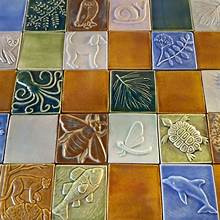
Introduction to Antique Tiles
Step back in time and envision the intricate beauty of antique tiles that have stood the test of time. These timeless pieces of artistry hold within them a rich history, showcasing craftsmanship that has been passed down through generations. Join us on a journey to explore the world of antique tiles, where each tile tells its own unique story through materials, techniques, and styles that continue to captivate admirers around the globe.
The History of Antique Tiles
Antique tiles have a rich history that dates back centuries, with origins tracing to civilizations like the ancient Egyptians and Romans. These early societies used tiles not only for practical purposes but also as an artistic expression of their culture and beliefs.
In the medieval period, Islamic artisans perfected intricate tile designs known for their geometric patterns and vibrant colors. The Moorish influence in Spain brought about stunning ceramic tiles that adorned palaces and mosques, showcasing exquisite craftsmanship.
During the Renaissance in Europe, Italian artisans excelled in creating elaborate tile murals featuring scenes from mythology or nature. The Dutch also made significant contributions to tile-making with their iconic blue Delftware tiles depicting pastoral scenes and maritime motifs.
As time progressed, different regions developed unique styles of antique tiles reflecting their cultural heritage. This diversity is what makes antique tiles so fascinating to collectors and enthusiasts today.
Materials Used in Antique Tile Making
Antique tiles are a testament to the craftsmanship of artisans throughout history. The materials used in creating these intricate pieces play a crucial role in their beauty and durability.
One of the most common materials found in antique tile making is ceramic, known for its versatility and ability to hold vibrant colors. Other popular materials include stone, such as marble or travertine, which adds a touch of luxury to any design.
Glass tiles were also favored for their luminous quality, reflecting light and adding depth to designs. In some cases, precious metals like gold or silver were even incorporated into the tiles for a truly lavish look.
Each material brought its unique characteristics to the creation process, resulting in stunning pieces that stand the test of time.
Techniques and Styles of Antique Tile Making
Antique tile making is a meticulous craft that involves various techniques and styles. One of the most common methods used in creating antique tiles is hand-painting, where skilled artisans meticulously paint intricate designs onto each tile. This technique allows for unique patterns and details to be added to the tiles, giving them a one-of-a-kind look.
Another popular technique is relief molding, where the design is created by pressing a mold into the clay before firing it in a kiln. This method adds depth and texture to the tiles, giving them an elegant and three-dimensional appearance. Some antique tiles also feature techniques like glazing or encaustic cementing, which involve adding layers of color or pattern onto the surface of the tile for added visual interest.
In terms of styles, antique tiles can range from traditional geometric patterns to elaborate floral motifs or even scenic landscapes. Each style reflects the artistic influences of its time period and region, showcasing the diversity and creativity found in antique tile making throughout history.
How to Care for and Preserve Antique Tiles
Antique tiles are not just beautiful pieces of history; they are delicate works of art that require special care to preserve their charm for years to come. To maintain the integrity and longevity of antique tiles, it is essential to handle them with caution. When cleaning antique tiles, avoid harsh chemicals or abrasive scrubbers that could damage the intricate designs. Instead, use a mild soap and water solution with a soft cloth to gently clean the surface.
To prevent scratches or cracks, place felt pads on the bottom of any objects that may come into contact with the tiles. Additionally, avoid placing heavy items on top of antique tile surfaces to prevent any potential breakage. Regularly inspect your antique tiles for any signs of wear or damage and address them promptly by consulting with a professional restoration expert if needed.
By following these simple care tips, you can ensure that your beloved antique tiles retain their beauty and historical significance for generations to come.
The Modern Use of Antique Tiles in Interior Design
In the realm of interior design, antique tiles are making a striking comeback, adding a touch of history and sophistication to modern spaces. Designers are incorporating these timeless pieces into contemporary settings to create a unique and eclectic look that blends the old with the new seamlessly.
One popular trend is using antique tiles as accent pieces in kitchens and bathrooms, where they can serve as focal points or statement walls. The intricate patterns and vibrant colors of antique tiles can add depth and character to any room, transforming it into a work of art.
Moreover, mixing antique tiles with more modern elements like stainless steel appliances or minimalist furniture creates an interesting juxtaposition that elevates the overall aesthetic of the space. Whether used on floors, walls, or even countertops, antique tiles bring a sense of charm and elegance that is hard to replicate with newer materials.
By embracing the beauty and craftsmanship of antique tiles in their designs, interior designers are able to create spaces that feel both luxurious and inviting – truly showcasing the enduring appeal of these exquisite pieces from centuries past.
Conclusion
Antique tiles are not just functional pieces; they are works of art that have stood the test of time. The intricate designs, craftsmanship, and history behind each tile make them a unique addition to any space.
By understanding the materials used, techniques employed, and the care required for antique tiles, we can appreciate their beauty even more. Whether it’s using them to restore historical buildings or incorporating them into modern interior design projects, antique tiles continue to captivate us with their timeless charm.
Embrace the artistry and craftsmanship behind antique tiles in your home or project today and let these historic treasures add character and elegance to your space.

